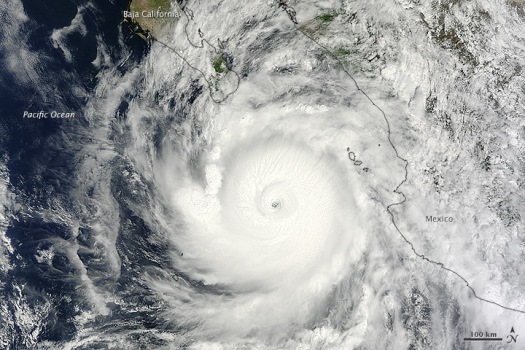North Atlantic
September 2014 Tropical Cyclone Counts
| Storm Type | September 2014 | September 1981-2010 Average | Record Most for September Period of Record: 1851-2014 |
|---|---|---|---|
| Tropical Storm (Winds > 39 mph) |
2 | 4.0 |
8 (2002, 2007, 2010) |
| Hurricane (Winds > 74 mph) |
1 | 2.6 |
5 (1955, 1969, 1981, 1998, 2000, 2005) |
| Major Hurricane (Winds > 111 mph) |
1 | 1.3 | 4 (1953, 1961) |
September 2014 Individual Tropical Cyclones
| Name | Dates of winds >39 mph |
Maximum Sustained Winds |
Minimum Central Pressure |
Landfall |
|---|---|---|---|---|
| Tropical Storm Dolly | September 1st–3rd | 50 mph | 1002 mb | Near Tampico, Mexico |
| Hurricane Edouard | September 11th–19th | 115 mph | 955 mb | N/A |
East Pacific
September 2014 Tropical Cyclone Counts
| Storm Type | September 2014 | September 1981-2010 Average | Record Most for September Period of Record: 1949-2014 |
|---|---|---|---|
| Tropical Storm (Winds > 39 mph) |
4 | 3.6 | 6 (1966, 1992, 1994, 1997, 2001, 2005) |
| Hurricane (Winds > 74 mph) |
2 | 2.2 |
6 (1992) |
| Major Hurricane (Winds > 111 mph) |
2 | 1.1 |
4 (1972, 1993) |
September 2014 Individual Tropical Cyclones
| Name | Dates of winds 39 mph |
Maximum Sustained Winds |
Minimum Central Pressure |
Landfall |
|---|---|---|---|---|
| Hurricane Norbert | September 2nd–8th | 120 mph | 957 mb | N/A — Direct impacts along Baja California, Mexico |
| Hurricane Odile | September 10th–17th | 130 mph | 922 mb | Near Cabo San Lucas, Mexico |
| Hurricane Polo | September 16th–22nd | 75 mph | 1003 mb | N/A — Direct impacts along Baja California, Mexico |
| Hurricane Rachel | September 24th–30th | 85 mph | 981 mb | N/A |
Significant Events
Odile developed from a low pressure system south of the Mexican Pacific Coast, reaching tropical storm strength on September 10th. Odile moved towards the northwest, parallel to the coastline and became a hurricane on September 13th. The storm then underwent rapid intensification, reaching its maximum strength on September 14th with winds of 130 mph (Category 4) and a central minimum pressure of 922 mb. Odile weakened slightly while undergoing an eye wall replacement cycle on the 15th before making landfall near Cabo San Lucas with winds of 125 mph (Category 3). The storm then moved along the Baja Peninsula, bringing flooding rains, winds, and storm surge to much of the region. The Mexican government declared a state of emergency, setting up shelters for thousands of local residents and over 26,000 foreign travelers visiting the Baja Peninsula. The system dissipated to a remnant low on the 19th and moved into the southwestern U.S. where the storm brought heavy rains to parts of drought stricken Arizona, California, New Mexico, and Texas. Odile's 125-mph winds at landfall marked the strongest hurricane on record to make direct landfall on Mexico's Baja Peninsula. Odile was also the ninth strongest hurricane on record to make landfall anywhere along Mexico's Pacific Coast. Over 90 percent of Baja California Sur lost power during the event, with an estimated 2,100 power poles being downed across the Mexican state. More than 11,000 people were evacuated due to flood waters alone. In Mexico alone, at least 15 fatalities were confirmed from the storm with damages expected to exceed one billion U.S. dollars.
 NOAA's National Centers for Environmental Information
NOAA's National Centers for Environmental Information
